




 [Rundweg Stadtbefestigung]
[Rundweg Stadtbefestigung]
History of Dorsten - Station 42: Lippetor
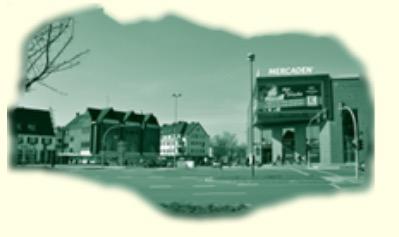
It was part of the fortifications of the Middle Ages. The Lippetor was a hard fought bridgehead in war-times. It was the location of the previous Hotel. "Hotel Goldener Anker", a clock with a Persil advertisement "Persiluhr" and a Nazi-monument for the paramilitary volunteers corps "Freikorps Lichtschlag".
And it was used again and again as a trading place: In earlier times as a catltle market and nowadays as a shopping centre.
|
Albert Magnus becomes Bishop of Regensburg.
| _ |
1260 |
_ |
Having been given town status in 1251 , the citizens fortified their town until 1260 with a palisade fence and a moat in front of it. Three town gates interspersed the fortification ring of the Middle Ages,, in the North, South and East. A trade route between the towns of Essen and Münster passed through the northern gate situated at the crossing of the River Lippe. |
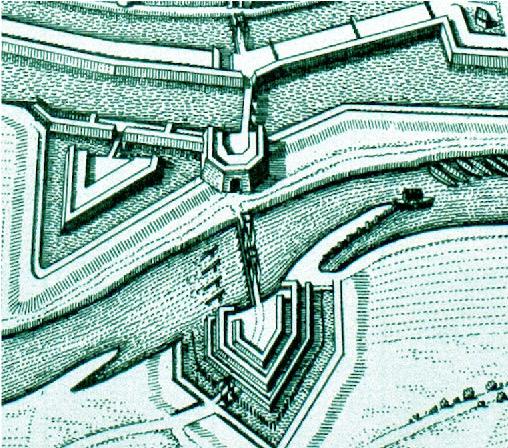 Extra bastion |
1633 |
_ |
During the 30 years War, the Hessian occupation forces erected an extra bastion in front of the Lippetor and a specially-strengthened bridgehead on the northern bank of the River Lippe. A bastion placed eastwards of the gate, known as "Halbmond" ("Half-Moon"), offers protection for the bridge over the River Lippe, "Lippebrücke". | |
|
|
1641 |
_ |
Imperial troops destroy the fortification ring, that the Hessians had built in front of the Lippetor and the neighbouring bastion "Finkennest" and re-conquer the town. | |
|
The Englishman, Henry Mill, receives a patent for a typewriter.
| _ |
1674- 1714 |
_ |
In the Franco-Dutch War ("französisch-holländischer Krieg"), the fortifications erected by the Hessians are razed to the ground. Parts of a bastion from the Lippetor of the Middle Ages remain, as well as a wide connecting moat between the River Lippe and the town moat. |
|
|
1827 |
_ |
After the destruction of the city gates, the outside walls of the Lippetor remain as parts of neighbouring buildings until the beginning of the 20th century. A cattle market starts uo between the Lippetor and the newly-constructed bridge over the River Lippe ("Lippebrücke"). A watchtower that is erected here, ensures public order. | |
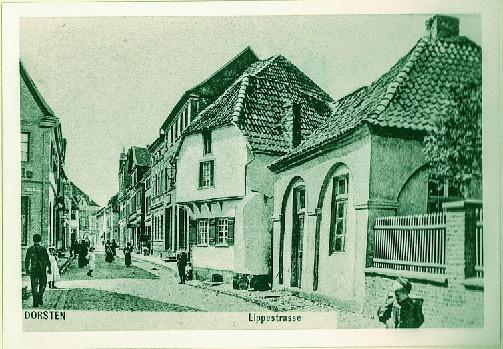 The street "Lippestraße" around 1900 |
1874 |
_ |
A grain Schnapps distillery ("Kornbrennerei") is establishe in front of the Lippetor. The distillery is extended in a location opposite it, to include a restaurant with a hotel business, which has had the name "Goldener Anker" since 1911. | |
|
Pope Benedict XV intercepts to end the war but to no avail.
| _ |
1915 |
_ |
Building works begins during the First World War, for the shifting of the River Lippe northwards and for the conversion of the old riverbed of the River Lippe into a navigable canal. Prisoners of War from England and France are set to work on this. |
|
|
1934 |
_ |
The Nazis (Nationalsozialisten) erect a Monument at the canal bridge for the paramilitary volunteer corps Lichtschlag (paramilitärische Freikorps Lichtschlag), that bloodily defeated the Spartacist Uprisings in Dorsten and surrounding areas, in 1919. | |
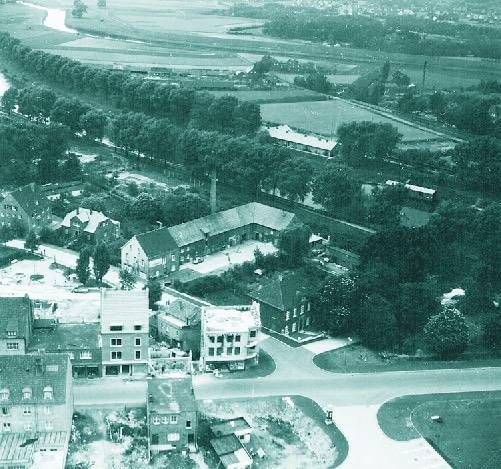 The Bövingloh distillere in the middle of the 1950's |
nach 1945 |
_ |
As part of the re-building following the destruction caused by war in March 1945, the noteable Hotel "Goldener Anker" is moved from its previous location at the Lippetor to its present-day location. In the 1950's it was necessary to raise the whole area by around two metres because of subsidence caused by mining, in order to connect the B224 road with the canal bridge. | |
|
The Great Proletarian Cultural Revolution (
| _ |
1966 |
_ |
Pre-fabricated buildings are put up in front of the Lippetor for the pupils of the secondary modern school "Realschule St.Ursula". |
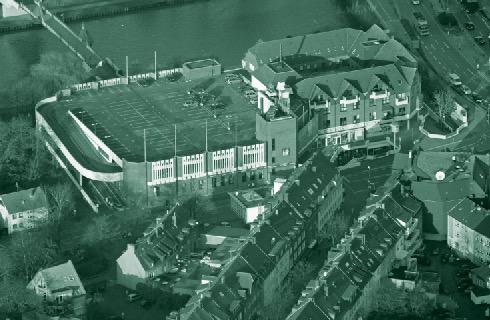 Lippetor-Centre ("Lippetor-Center") |
1982 |
_ |
The Lippetor Centre ("Lippetor-Center") (previously known as "Wilma-Center") has a magnetic attraction for the public in the first years. Several changes in ownership and an intermediate administration order resulted in a compulsory auction in 2010. | |
|
|
2016 |
_ |
A new shopping complex, the "Mercaden" opens its doors at the site of the previous Lippetor-Centre ("Lippetor-Center"). |
[zurück]
Daten und Fakten
Eröffnung - 28th June 2016
Adresse - Lippetor 2
Geodaten - 51°39’46.10 6°57’52.80
Celebratory Presentation on 28th June 2016

Tobias Stockhoff thanks all of those involved (in the project)
The newest version of the Lippetor is located at the upper end of the street "Lippestraße", level with the entrance to the former menswear shop "Mensing". And it is a "First".
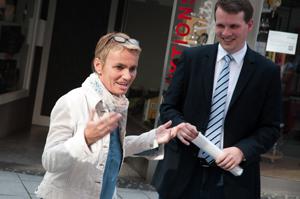
The Headmistress of the secondary modern school
The pupils of the secondary modern school, "Erich-Klausener-Realschule" took on the design of such an information-stele, for the first time. The texts are based on an exhibition about the previous town fortifications of Dorsten, which the History Club had presented a few months before at the Open Day of the school.
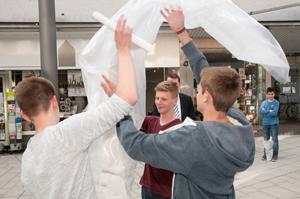
Die Schüler der EKS enthüllen die neue Geschichtstafel.
Das Lippetor ist ein Ort, der Geschichte geschrieben hat und diese Historie haben in freiwilliger Arbeit engagierte Dorstener Schüler mit ihrem damaligen Geschichtslehrer Rene Franken für die Öffentlichkeit aufgearbeitet. Knapp und komprimiert, mit Bildern und Zeitleiste und in bekannt-bewährter Form einer Dorstener Geschichtsstation.
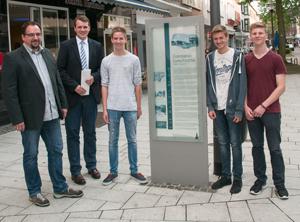
The Mayor, Tobias Stockhoff with pupils and teachers
We had so much information, that we had the feeling we could put up 20 History Sation plaques. here, ("Wir hatten so viele Informationen, wir hätten gefühlt 20 Geschichtstafeln hier hinstellen können") related Lars Erwig, who, together with his colleagues from the 10th year, Pascal Czlapa and Sebastan Beuth gave an insight at the presentation of the information plaque, into the work of the History Club.
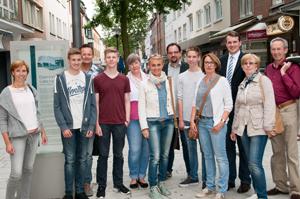
Group photo of the Ladies
In addition to other information, the pupils brought awareness to the fact that old wooden supporting beams had been found during the building of the shopping complex, "Mercaden" and that these had been used for the previous fortification of the town wall.
The paving starts to show form - but inconspicuously one shade of colour in another
Lars Erwig made the visitors aware of the new paving in front of the History Station: It shows a true-detailed plan of the former town gate of the Middle Ages, that stood exactly at this position. That was also very necessary because not very cleverly, the depiction of the gate has the same colour as the background and the picture can only be recognised in the direction of the paving.
Translator's Note: The source for the German text is given as: (Bericht: Dorstener Zeitung von Michael Klein)

